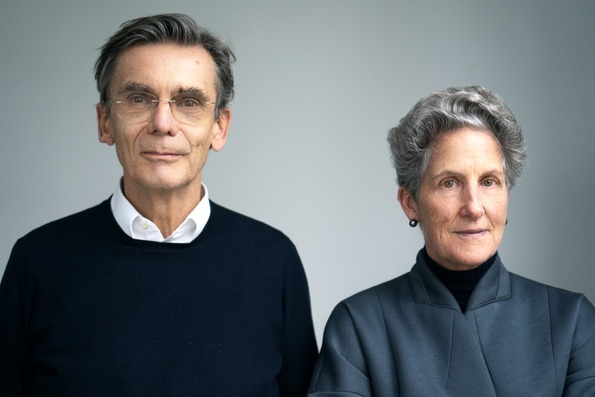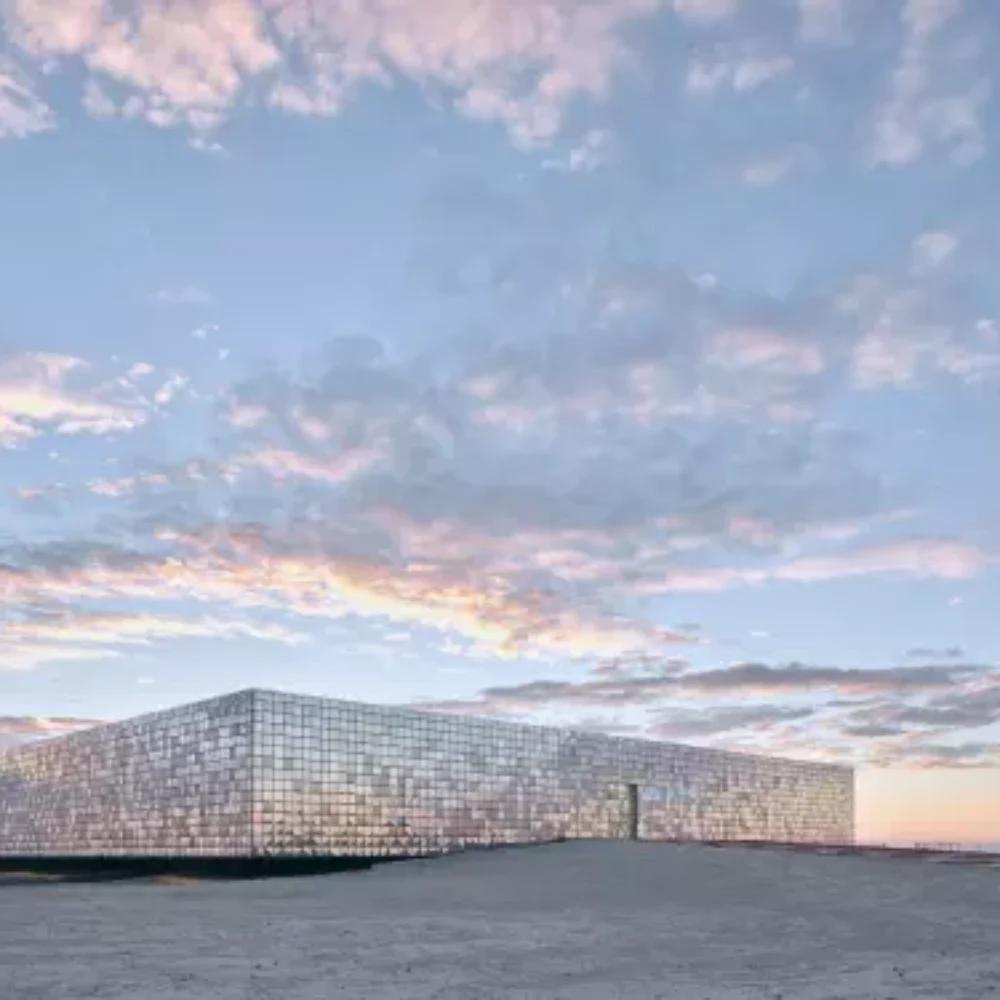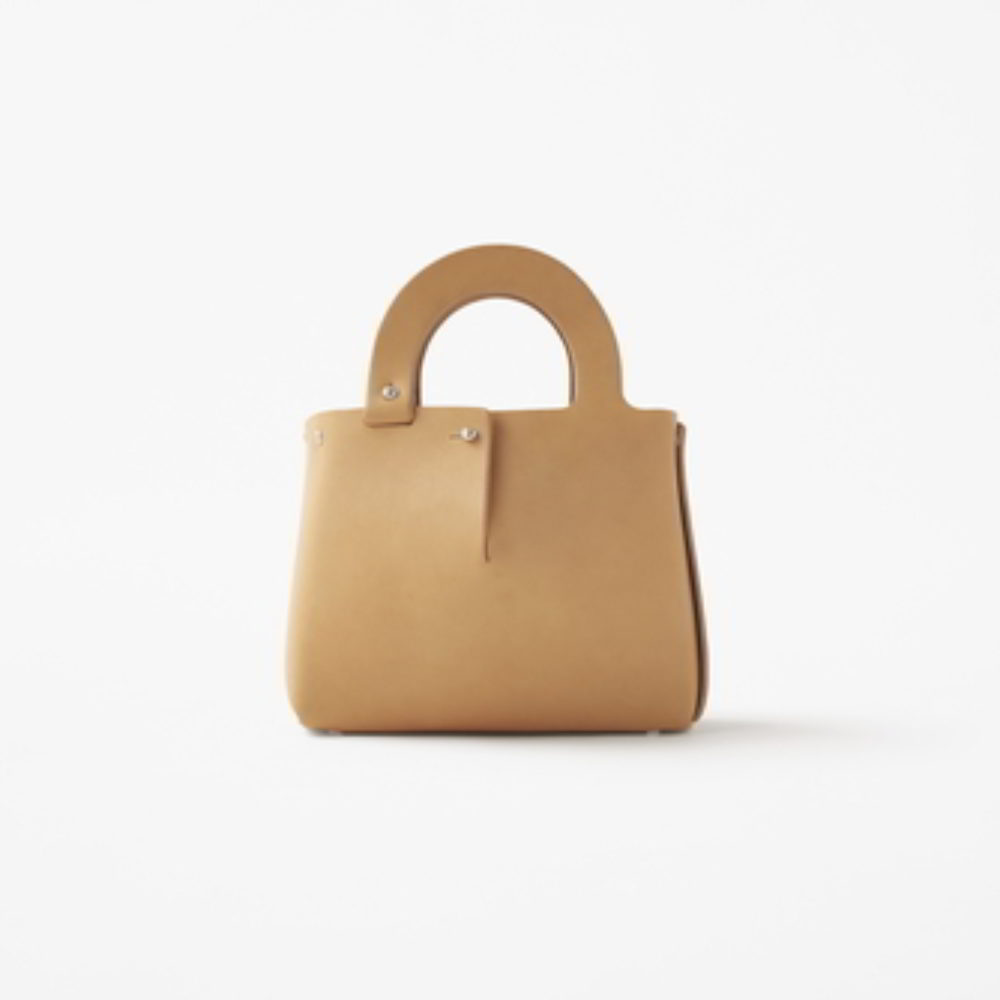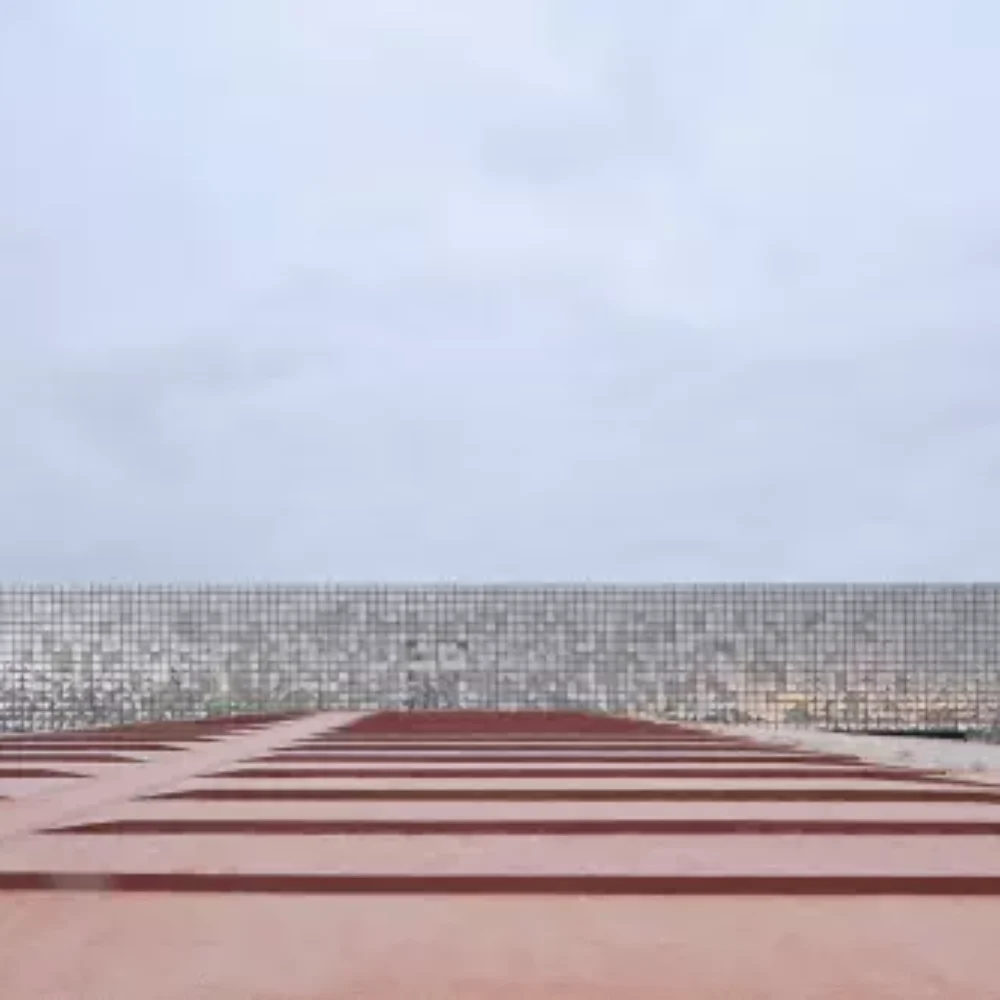The Tchoban Foundation in Berlin is showing the graphic work of Matthias Sauerbruch, Louisa Hutton and their studio for the first time at its Museum of Architectural Drawing from 3 February to 5 May 2024
16 February 2024 | Özlem Özdemir
I
f there is one architectural firm whose work you can get to know at an exhibition and afterwards set off to experience the exhibited works live, at least a few, then it is Sauerbruch Hutton. With Sauerbruch Hutton – drawing in space, the Berlin-based Tchoban Foundation, which founded a museum for architectural drawing in 2013, offers an insight into the drawings and architectural representations of the renowned Berlin office.
Who is the duo Sauerbruch Hutton? Matthias Sauerbruch (1955) is the son of the painter Hans Sauerbruch and grandson of the surgeon Ferdinand Sauerbruch. He studied at the HdK Berlin and graduated from the Architectural Association School of Architecture (AA) in London. In the 1980s, he was a partner at the Office for Metropolitan Architecture (OMA) in London, working with founding partner Ilias Zengelis. Louisa Hutton (1957) studied at the University of Bristol and the AA. She then worked with Alison + Peter Smithson for four years. In 1989, she founded the office in London together with Matthias Sauerbruch.
Sauerbruch Hutton has been based in Berlin since 1993 (more on their relocation later). They have completed around 20 projects for the capital. Perhaps the most astonishing of these is Haus 6 (2017). Its building envelope consists of a mirrored surface that makes the building shimmer like a fatamorganic apparition as you walk around it. But that is not what is so striking about the building. In the context of Sauerbruch Hutton’s oeuvre as a whole, it stands out as an extreme, as an object without any colour of its own, and even more so, as something completely free of what the general public likes to associate with Sauerbruch Hutton’s architecture: Polychromy.
Colour is the perfect way to highlight something or someone. You could witness this at the GSW Headquarters in Berlin when Sauerbruch Hutton not only upgraded it ecologically in 1999 but also turned it into an eye-catcher. A slab-shaped highrise building from the 1950s finally got the chance to make an appearance and, with it, Sauerbruch Hutton. The redesign of its concave façade made of glass and metal grid is surprising in its use of elements that are actually quite simple: Each window is fitted with with mobile sun blinds in one of several shades between pink, orange and red. The colour scale remains the same, but the façade changes its hue depending on how people use its shades. Since then, Sauerbruch Hutton has shaped the image of Berlin’s city centre near Check Point Charlie and reminded the German architecture scene of the magic of façades and colours.
The GSW project is considered the starting signal for the then-young office. After winning the GSW competition in 1991, Matthias Sauerbruch and Louisa Hutton moved from London to the newly reunified Berlin. Kristin Feireiss gave them extra support in 1992 by organising an exhibition in her gallery, Aedes. (Even the world-famous architect of US modernism and postmodernism, Philip Johnson, did not miss it1.)
And now, more than 30 years later, Kristin Feireiss is curating the exhibition Sauerbruch Hutton – drawing in space. Sauerbruch Hutton has long since become an award-winning international studio for architecture, urban planning and design. With their team of 100 employees, they build far beyond the borders of Germany. Their architectural work includes residential buildings, museums, educational buildings, high-rise office blocks and entire urban areas – what is a diverse range. Sauerbruch Hutton stands for a responsible, varied modernism, a Modernity without Dogma2. Kristin Feireiss has compiled the drawings the German-English firm has generated over 35 years. Some of them even date back to her student days.
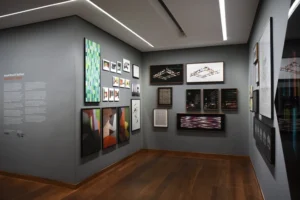
The Tchoban Foundation presents the works of Sauerbruch Hutton in its museum for the first time: design studies, presentation and concept drawings by Matthias Sauerbruch, Louisa Hutton and their studio. They date from 1983 to the present day. The graphic techniques include charcoal drawings, drawings with pastel chalk, photo collages, photographically enlarged pencil and ink drawings, digitally processed hand drawings and purely digital drawings.
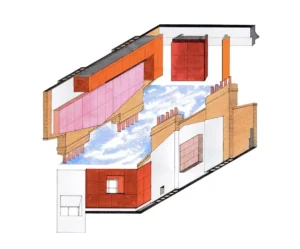
The first room contains 81 works on loan from the office. L House (London, 1992, watercolour, pencil) is one of the earlier examples. Entirely in the Zengelis style, the axonometric depiction is, at the same time, calm and irritating. It looks like a mixture of sections and views. The coloured image in white, black, blue, pink, red and brown does not present a house and its context. It shows walls that appear to be standing and floating, lying vertically and overhead, framing a surface with a section of sky and otherwise not defining an enclosed space and therefore not a house. The presentation resembles an aesthetic etude, a test of colours in space. In fact, this playful exercise finally turned serious: L House is the first realised project in which Sauerbruch Hutton have used colour as a material. Other exhibits include, among others: Olympic Swimming and Cycling Halls, Berlin (1992, ink, coloured film), Photonics Centre, Berlin (1995, Kohlestift, farbige Folie), Brandhorst Museum, Munich (2002, Fine Art Print) und Kinetik, Boulogne-Billancourt (2012, fine art print).


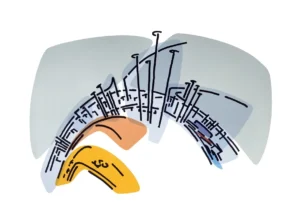
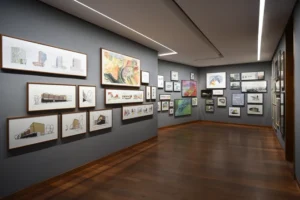
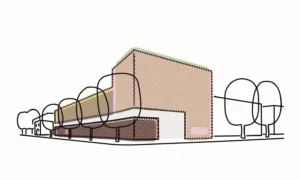
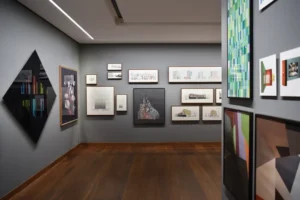

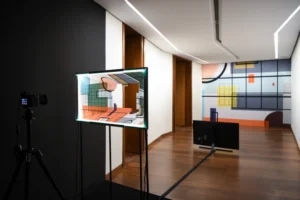
The museum’s second-floor hall features an interactive installation created created by the studio exclusively for this exhibition. The installation extends the graphic into the space, allowing visitors to enter a drawing and have a playful experience with dimensions.
What predestined Sauerbruch Hutton for a presentation in a museum of architectural drawing? Naturally, the Tchoban Foundation is interested in how the computer age, virtual reality and AI influence drawing by hand, and how and whether such technological trends change analogue drawing and its status. But to put it another way: What does drawing mean to Sauerbruch Hutton themselves? The duo are critical of the so-called non-Euclidean spaces that are flourishing worldwide thanks to complex programmes. „We use our aesthetic judgement to study the form of a building through drawings and models […]“, said Matthias Sauerbruch at the Fritz Schumacher Award ceremony3. You can read his speech on his website.
As generously as Sauerbruch Hutton offer their lectures and publications on their website, you won’t find much about drawing there. Even the project descriptions contain virtually no drawings. (By comparison, the Madrid-based architect Campo Baeza offers many of his drawings online, inviting you to ‚view all sketches‘).
On the other hand, just a few years ago, in 2021-2022, there was an exhibition of drawings by Sauerbruch Hutton at the M9 museum district in Venice-Mestre, which, interestingly enough, they designed themselves. The title was: draw love build. The fact that ‚drawing‘ is the first word in the title may well have some significance. The location is also significant, especially if you think of Carlo Scarpa. (Scarpa, an architect and child of Venice who felt called to draw and elevated architectural drawings to works of art, said, as minimalistically as his architecture: „I put things here in front of me, on paper so I can see them. I want to see, and this is why I draw.“4)
How does Sauerbruch Hutton’s approach to drawing differ from that of other colleagues? Steven Holl, for example, spends the first few hours of the day painting and has produced at least 10,000 delicate pastel aquarelles. He says of himself: „If everybody else quits drawing, it’s fine with me“5. Alvaro Siza is famous for his sketchbooks filled with softly drawn black lines, keeping him constantly on a design quest. He professes that he is dependent on drawing and sketching.
Sauerbruch Hutton’s drawings in the Tchoban exhibition show less of a typical style than those of Holl, Siza and Scarpa. Nor does the focus seem to be on exploratory drawing and the search for design ideas. This suggests that even though their drawings contain black and white images, and some may be design studies, the theme of colour plays a dominant role in their drawings. For Sauerbruch Hutton, drawing is a medium for experimenting with colours, their combinations and their effects on forms, proportions, spaces and surfaces. Pencils and strokes are not at the forefront of their work. Sauerbruch Hutton’s motto is: „For us, colour is a tool“6. It is fair to say that for Sauerbruch Hutton, colour is the tool par excellence.
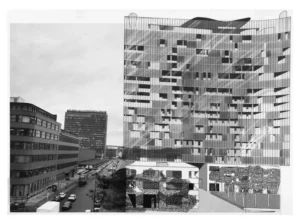
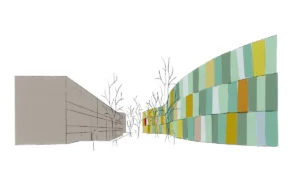
Sauerbruch Hutton regard colour as both a material and a means of adding depth, rhythm and vibrancy to their façades, at least to some of them, at least some of them ( we must not forget that Sauerbruch Hutton can also work without colour). The polychrome, finely rastered and harmoniously structured façade look, their trademark, is often reminiscent of moving pixel structures, weaving frames in progress, reliefs or dynamic paintings. One of Sauerbruch Hutton’s most compact projects, City Dress (a full-body cover with an unmistakable Sauerbruch Hutton pattern), puts it in a nutshell: for the German-English duo, the façade is an almost independent layer, a structure, a fabric that surrounds the buildings like skin and clothing surround the human body.
How do Sauerbruch Hutton proceed when it comes to polychromy? In an interview, they explain how they use colour like form and light: “Our initial idea incorporates a general concept of a color or colorgroup. Normally we draw on the NCS system, which comprises almost 2000 colors. The biggest challenge is to find a way to apply the desired color to the relevant material. We collect colorsamples, products, and other reference materials that can help us to communicate our concept to the firms or manufacturers responsible for making our concept a reality. They need to understand our color concept if they want to apply it, for instance, to glass or ceramics.”7
When asked how they see the link between colours and materials, they reply: „We try to find a profound material quality in the color and to link color edareas with the surface characteristics of the materials involved. At the Brandhorst Museum in Munich, for example, the surface structure of the ceramic rods can only be discerned from close up. From further away, the individual rods combine to form large areas of neutralized color, which creates the impression of a large abstract painting with three different color zones. The combination of materiality, color, and color composition produces a completely new, oscillating building surface.“8
The possibilities of polychromy are so important to Sauerbruch Hutton that they do not limit themselves to drawing techniques alone. One room in their office is dedicated entirely to colour. This is where they test colour combinations, free of computers – completely analogue. And Sauerbruch Hutton know their role models. They have studied the architects, painters and colour researchers Gottfried Semper, Bruno Taut, Theo van Doesburg, Le Corbusier and Josef Albers. However, they do not follow their role models like their masters but are inspired and reinterpret what they have learned. They do not follow methods or abstract systems (such as Emmanuelle Moureaux, a French architect who works in Japan and is using the self-developed shikiri colour concept). More crucial to Sauerbruch Hutton than doctrines and theories is trial and error and the emotional and sensory experience right up to the end.Their 1:1 scale façade mock-ups are evidence of this: they use them to adjust the fine tonal gradations of, for example, coloured glazed ceramic pieces in natural light.
One particular source of inspiration should not go unmentioned, especially as it traditionally goes hand in hand with drawing: travelling. Matthias Sauerbruch describes India – Chandigarh, Delhi, Bombay, Rajasthan – as one of their most meaningful architectural journeys. „The continent, the mentalities, have dimensions that are overwhelming, at least for me! There is a power and sensuality and joie de vivre that is truly admirable. Of course, we didn’t come back and say, now we’re going to do it like those in India, but it was an experience that left a lasting impression on us.“9
Sauerbruch Hutton enjoy (as they perhaps experienced for the first time in India) uniting aspects that appear contradictory. They combine the rational with the sensual, sustainability with elegance, and systematics with intuition. They dress their buildings in dark colours, black and white, wood and copper and even reflective materials. Above all, they are not chromophobic, quite the opposite. Nevertheless, their colour scales are never jarring but soft to iridescent. They are usually balanced, despite their often dynamic potential. Sometimes, the colours are the co-creators in the hidden interior, and sometimes, they act on the „prominent“ façades, but they never result in superficiality. Quite the reverse, the colours reinforce the three-dimensionality of the façade structure. It is these colours that give the surfaces their Sauerbruch Hutton profile. All of this can be felt (with some knowledge of their projects) in their images. With Sauerbruch Hutton – drawing in space, the Tchoban Foundation demonstrates the rich drawing processes behind their built spaces. ♦
Translated from the German by Özlem Özdemir
¹ https://www.aedes-arc.de/cms/aedes/de/programm?id=356923; last access date 14.02.2024
2 https://www.sauerbruchhutton.de/en/essay/moderne-ohne-dogma; last access date 14.02.2024
3 https://www.sauerbruchhutton.de/en/essay/die-wenigen-dinge-die-wir-ueber-architektur-wissen; last access date 14.02.2024; letzter Zugriff 14.02.2024
4 https://www.architectural-review.com/essays/reputations/carlo-scarpa-1906-1978; letzter Zugriff 14.02.2024
5 https://metropolismag.com/projects/steven-holl-drawing/; last access date 12.01.2020
6 (2010). Sauerbruch Hutton ‘For us color is a tool’. In: Glasner, B., Schmidt, P. (eds) Chroma Design Architecture & Art in Color. Birkhäuser Basel, p. 280; https://doi.org/10.1007/978-3-0346-0446-8_6; last access date 14.02.2024
7 ibid.
8 ibid.
9 Alix Röttig, Im Gespräch mit Matthias Sauerbruch, Architektur Schweizer Ingenieur und Architekt Nr. 3, 18. Januar 2000, p. 31 ff. (Translated from the German by the author)
